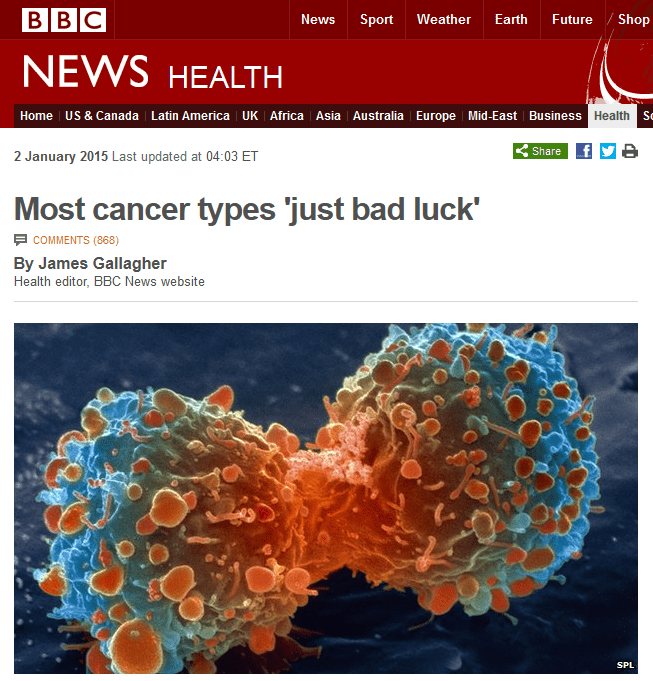Just as 2015 was getting underway, there was a sudden flurry of chatter swirling about headlines like this:
That “bad luck” spin came courtesy of the headline on a press release about a new study in Science, which suggested that only about a third of all cancers can be attributed to environmental factors. The rest were due to random cell mutations – a/k/a “bad luck.”
Within a couple weeks, a clarification appeared in Science’s news area: It’s not that most cancers are due to bad luck, explained the original paper’s authors; it’s “that two-thirds of the variation in cancer rates in different tissues could be explained by random bad luck.”
That doesn’t make for such an attention-grabbing headline, though. Meantime, mainstream media sources moved on.
As Dr. David Hunter, Harvard’s Vincent L. Gregory Professor in Cancer Prevention, has pointed out, the “bad luck” story as originally told goes against “the vast majority of research.” That research tells us that most cancers are “theoretically preventable.”
The challenge in this lies in actually pinpointing causes.
We use the word “cause” with circumspection in the fields of medicine and public health. Even when a pedestrian dies after being hit by a car, there may be other factors — weather, road conditions, alcohol use by the pedestrian or driver — that contributed to his or her death.
“For any individual,” Dr. Hunter explains further in a brief interview on the Harvard School of Public Health website,
— even a heavy smoker — it’s possible that their lung cancer was caused by something else. There are other risk factors for lung cancer — certain chemical exposures, radon, etc. — so it’s very difficult for an individual to know exactly why they got their form of cancer and because there are few exposures that cause cancer in 100% of people exposed, there is a chance component for the individual.
In fact, we can probably safely say that for most chronic health problems, it’s never just one isolated cause. Many factors are at play. Not all of them are under the direct control of the individual.
Consider a person who has developed an autoimmune disorder. For years, they had enjoyed good health, despite having had a mouthful of mercury fillings. But along the way, perhaps they had root canal treatment on a tooth or two – another source of toxicity.
Or maybe they had a tooth extracted and the periodontal ligament was not removed, so eventually, a cavitation formed in the bone below the surgical site. That area of dead, decaying tissue is a potent source of infection.
Or maybe the tooth was extracted perfectly and replaced with a titanium implant. With mixed metals in the mouth, galvanic currents are created, which hasten the release of mercury from the old amalgams.
On top of this, let’s say that the person favors a diet high in added sugars, hyper-processed foods and very few fresh vegetables and fruit. They work long hours at a desk job and find few opportunities (let alone much desire) for exercise or other physical activity. They take drugs to get immediate relief from a host of ills. Like most Americans, every day they’re exposed to smog/emissions, fluoride and pharmaceutical traces in the water supply, increasing levels of EMF radiation, chemical fumes released from all manner of consumer products…
So can we say that the mercury fillings alone caused the problem?
Of course not. They are one of many factors. Maybe it was the root canal that was the final straw. Maybe it was the implant. Maybe it was something else. All of the above have some role to play in the emergence of illness.
The sensible thing to do is evaluate, set healing priorities, then gradually address each insult to the person’s health, making sure they have proper nutritional, supplemental and lifestyle support to heal at every step in the process.
It would be nice – certainly easier and more convenient – if all health problems were simple one-cause, one-effect matters. But as we mentioned before, optimal health requires that we move beyond old linear ways of thinking to a systems-based approach.
For health is dynamic. It is a process, not a static state. The biological paradigm acknowledges this complexity and works within it to promote the wellness of our patients.
